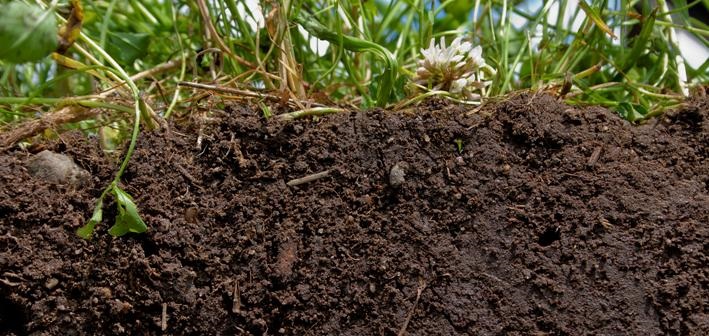
Energy crops can improve EU soil fertility
Perennial agriculture to produce energy crops can improve EU soil fertility. There is strong evidence that biomass for energy acknowledges soil health benefits and carbon sequestration. Solid biomass such as straw or woody chips has been promoted in Europe to produce heat, power, and 2nd generation biofuels. The EU Commission expects huge growth for biobased industries that will require massive amounts of biomass feedstock in the next few decades. Biomass is already a very considerable share of total renewable energy in Europe and most trends show a huge increment and potential for 2030.
In this article, we show how residues for biomass are not the right approach in Europe to promote a biobased industry. EU soils require perennial cropping systems to increase soil fertility. Energy crops have been studied for many years and meet that requirement successfully.
Why Europe should promote crops for biomass and cannot use only residues to promote a biobased industry?
Most policymakers and renewable energy organizations promote biobased products and renewable energy. However, even if goals and policies are increasing the interest in solid biomass wastes (agriculture and forestry residues) to produce heat, power, or 2nd generation biofuels, then a wrong approach considering soil sustainability is evident. Below is a TED video showing some of our vision that is 100% coincident with the most highly reputed researchers and ecologists combating climate change and creating soils worldwide.
What is the effect of residual removals on soil fertility?
Cereal straw, which is most often returned to the soil in arable cropping systems, is of renewed interest as a potential source of bioenergy. However, the sustainability of this practice which implies systematic removal of aerial biomass of cereal crops is a controversial issue, particularly in soils having a low soil organic carbon (SOC) content.
There is sound evidence that soil can be affected and damaged seriously from straw collection in large scale management at a farm level. Straw coverage increases topsoil C and N contents, moisture, and total porosity as well as reduces the variability of topsoil temperature and in turn moderated microbial biomass and activity. Additionally, soil carbon changes in the soil can determine large fossil inputs required from nitrogen fertilizers as organic matter reductions can occur in the topsoil. This has been extensively proven by scientists in Europe and many other regions worldwide. A short review of most sound scientific evidence and long term studies is available in the literature. Graham etal., 1986; Amir and Sinclair 1996;Børresen, 1999; Turleyet al., 2003; Blanco-Canqui, and Lal, 2007;Saffih-Hdadi and Mary,2008; Tarkalson et al., 2009; van Groenigen et al., 2011; Yoong et al., 2012;Nguyen et al, 2013; Weiser et al., 2013).
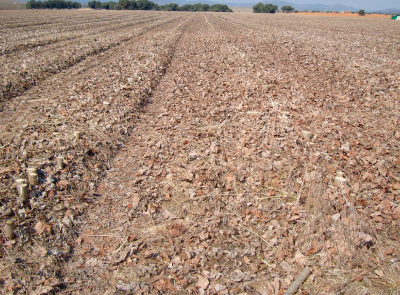
Soils in Southern European countries require perennial agriculture, green covers, and increments in organic matter that only biomass for energy markets could become real. Most livestock and grazing agriculture have been diminished by Common Agricultural Policy and there is no expectation to increase extensive grassland or perennial grasses for fodder production.
Is mulch agriculture what our soils need?
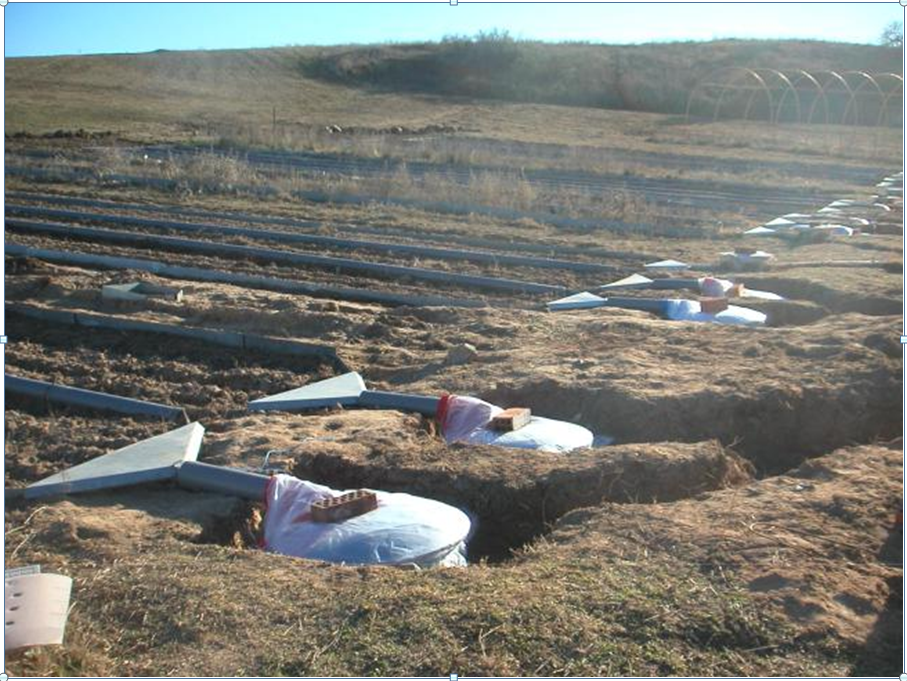
Experimental fields of Erosion Research group of CSIC in Santa Olalla”, Toledo, Spain
Before that question, we need to ask ourselves why perennials improve so much organic matter. In literature, the background on mulch agriculture is overwhelming and full of examples.
Perennial crops for woody energy plantations like poplars or willows but also perennial grasses or even broadleaf crops like cardoon, produce huge amounts of leaves and biomass residues going from air CO2 to become carbon in the soil (SOC), even in non-oxidable forms lasting for many decades. In a study in Spain with poplars, values from 1 to 7 tons of dry matter have been recorded as net increments in soil.
Some perennials are very much viable options to produce low cost biomass in marginal lands (such as semiarid and extremely warm or cold conditions).
Harvest losses and falling leaves have been recorded in Europe to add more than 1 ton of organic matter each year. Minerals and organic nitrogen as well as carbon sequestration increments have been measured every year.
Is biomass from energy crops compatible with increments in soil fertility?
The fact that most perennial crops require less fertilizer is explained mainly because of the net increment in carbon and organic matter in the soil. The approach in most research centers in Europe is that soil has to be stable if the land is considered to produce biomass for energy.
When analyzing Life Cycle Assessments in literature for energy crops or biomass energy, one of the most important factors is the fossil energy used for the energy obtention process.
In annual energy crops, diesel and nitrogen fertilizers used account for around 60-80% of all energy consumed to produce a gigajoule of energy. Nitrogen fertilizers and diesel utilized by tractors and other operations are critical but a second aspect is important too: if you plow every year, less organic matter will be accumulated in the soil. In perennial crops, increments in organic matter determine low dependence on nitrogen fertilizers and energy balances because of mineralization and lower nitrogen volatilization as ammonia or nitrates. Harvest losses return several macro elements like phosphorous, potassium, or calcium. The increment in organic matter stabilizes the soil, holds moisture, and increases yields in the same year, but also in subsequent years. Rotations with perennials might indeed boost our food production.
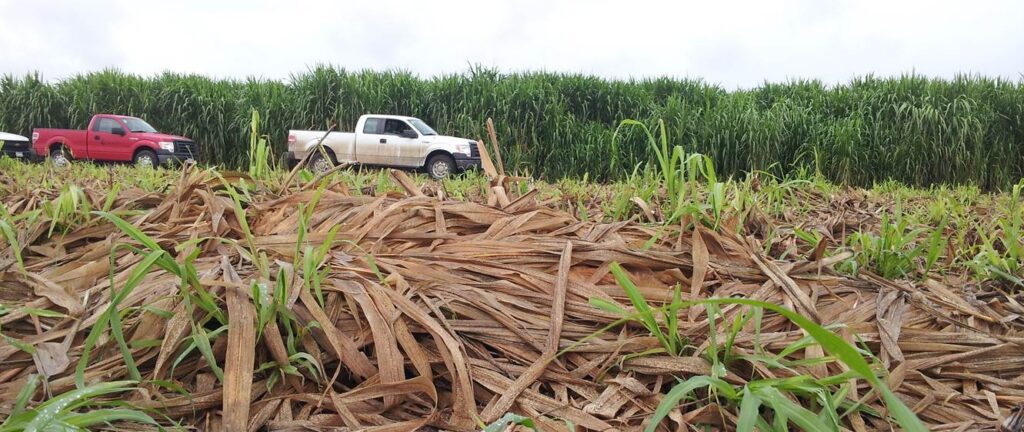
Organic matter in the soil using grasses is estimated to increase carbon sequestration between 0.5 and 1.5 Mg/acre each year. Topsoil building is critical for farmers working on sustainable bioenergy crops in marginal lands and fragile areas.
Are legumes viable options as perennial crops for energy?
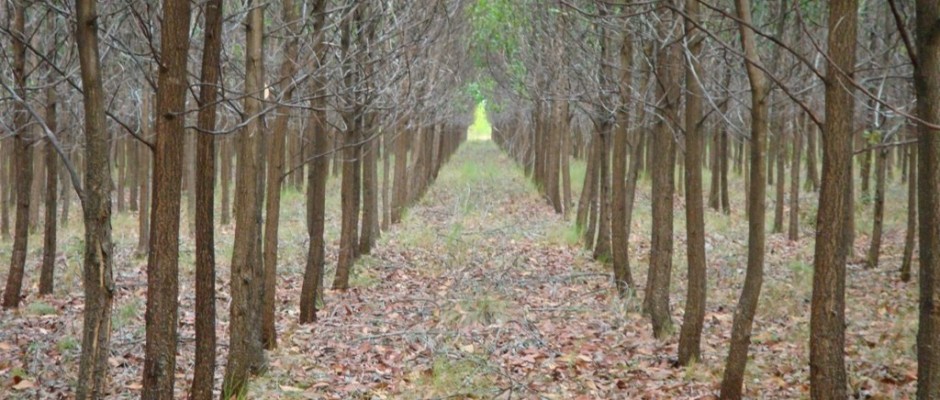
Fixing nitrogen legumes could avoid lots of fossil energy used to produce biofuels in other species, but it is not enough well considered in standards and certifications.
Fixing nitrogen species are those plants that can use nitrogen in the air and fix it in roots with symbiotic bacteria like rhizobium or rhizobacter. Legume trees are a hotspot for biomass to energy projects. They can improve the soil and return carbon and nitrogen increasing fertility. Several options are viable across Europe including species like Leucaena, Robinia, Acacias, and many others.
Soil sustainability is low in the present, because of cereal monocultures, erosion, and lack of adequate rotations with grasses, woody crops, or fallow agriculture.
Could we build topsoil with carbon negative solutions?
There are some options to increase carbon furthermore. Additional to biomass harvest losses, perennial rooting systems, and falling leaves, some biomass-to-energy technologies can offer solid biomass wastes that could be used as organic fertilizer to improve soil fertility. Two examples are pyrolisis and anaerobic digestion (AD). In the first one, solid biomass is used to produce energy with a byproduct called “biochar” which is commercially used as a soil amendment. Several companies offer commercial solutions for pyrolisis and biochar which benefit soils and industry cash flows at the time that farmers obtain a benefit from biomass to energy projects.
A good explanation of some of the benefits of biochar from woody biomass can be found in this video:
The same applies to AD and liquid or solid digestate produced from co-digestion of silage and manure or vinasse.
So, not only perennial energy cropping systems can benefit the soil, but also residues from biobased industries will create topsoil fertility and carbon
Useful links on soil improvement and fertility:
Sub-surface soil carbon changes affects biofuel greenhouse gas emissions
The effect of native and introduced biofuel crops on the composition of soil biota communities (2014)
Net ecosystem production and carbon balance of an SRC poplar plantation during its frst rotation (2013)
What is the potential for biogas digesters to improve soil fertility and crop production in Sub-Saharan Africa?
Soil-carbon sequestration and soil-carbon fractions, comparison between poplar plantations and corn crops in south-eastern Spain (2013)
Grassland carbon sequestration and emissions following cultivation in a mixed crop rotation (2012)
Perennial bioenergy crops programme from Rothamsted Research Centre (UK)
Medium-term effect of perennial energy crops on soil organic carbon storage (2011)
Carbon-Negative Biofuels from Low-Input High-Diversity Grassland Biomass (2006)
Soil: Carbon Sequestration in Agricultural Systems (2014)
Dynamics of soil organic carbon pools after agricultural abandonment
Carbon dioxide sequestration model of a vertical greenery system
Paving the way for sustainable bioenergy in Europe: Technological options and research avenues for large-scale biomass feedstock supply
Effects of bioenergy crop cultivation on earthworm communities—A comparative study of perennial (Miscanthus) and annual crops with consideration of graded land-use intensity (2011)
Perennial energy cropping systems affect soil enzyme activities and bacterial community structure in a South European agricultural area (2014)
Potential of Perennial Crop on Environmental Sustainability of Agriculture
Establishment of a native bunch grass and an invasive perennial on disturbed land using straw-amended soil (2013)
Dynamics of soil fauna after plantation of perennial energy crops on polluted soils (2013)
Changes in soil phosphorus forms through time in perennial versus annual agroecosystems (2014)
Impact of land-use change towards perennial energy crops on earthworm population (2014)
Life cycle assessment of different bioenergy production systems including perennial and annual crops (2011)

